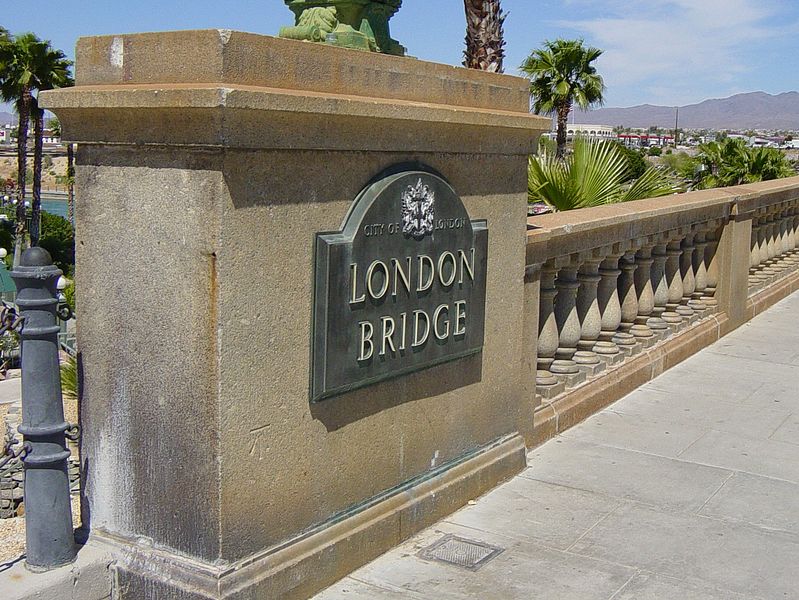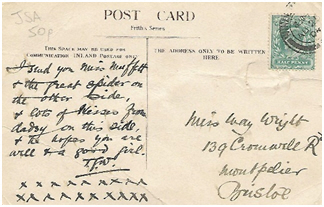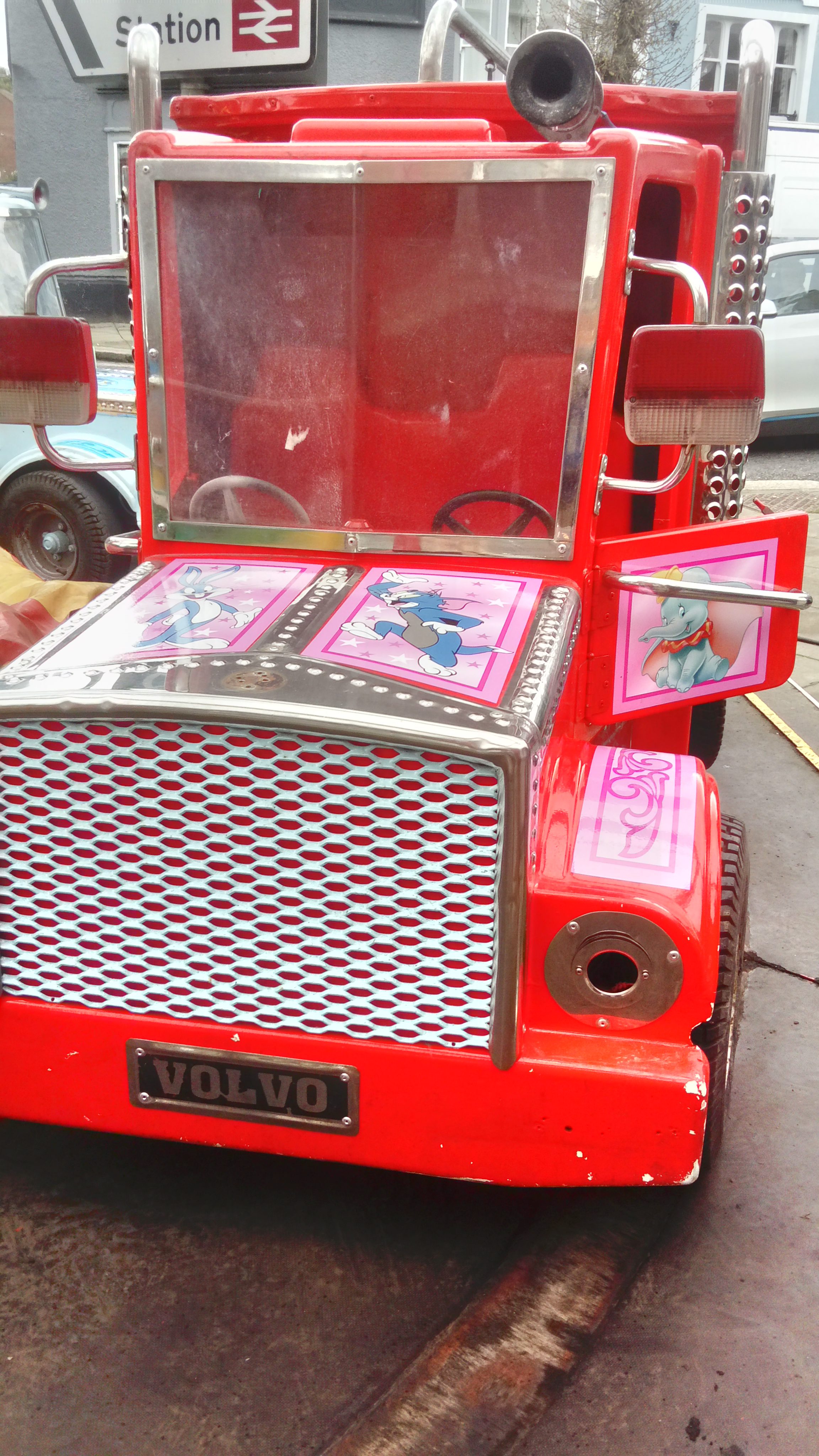
Hungerford Arcade “Our Own Vintage Fashion Evening”
Hungerford Arcade Facelift

You may have noticed the scaffolding up over the last few weeks and wondered what was happening to the Arcade. Well fear not – it isn’t being pulled down or converted into flats or anything quite that exciting.
We have had some minor roof repairs done and the entire frontage repaired and repainted.
To the untrained eye, it will look no different at all as we have stuck to our old familiar colours and our new signs will be our old familiar logo – so no big changes. Just fresh and clean. As it should be.
The most exciting bit was the view from the roof!
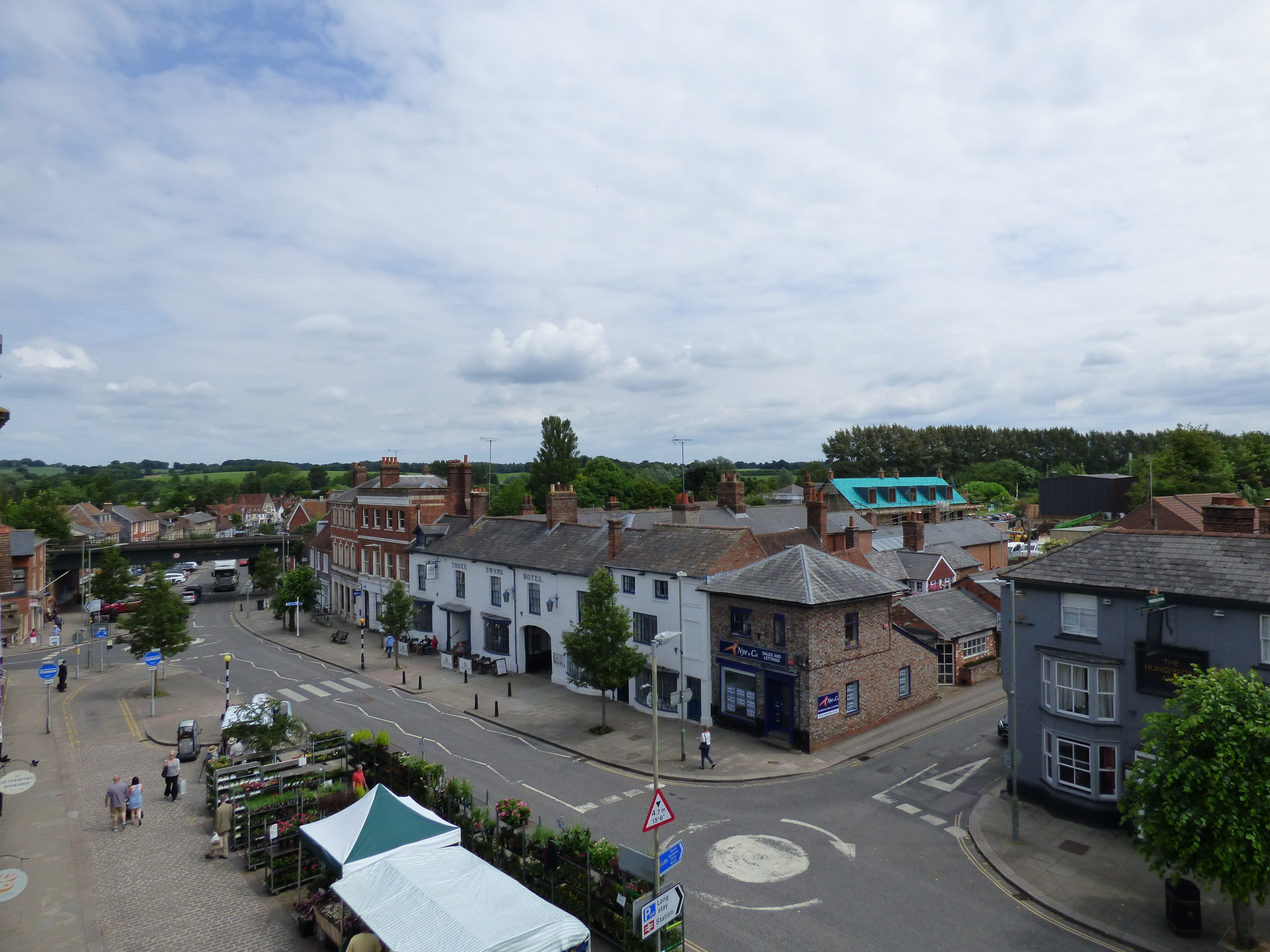
Hungerford Arcade Classic Car Show – Part 2
Hungerford Arcade is very proud to publish Part 2 of our Classic Car Show, courtesy of the West Berkshire Classic Vehicle Club.
Again, Thank you Colleen and Mike Kent of the WBCVC and all the Members who brought their wonderful vehicles along to the Arcade which made for a great family day out, enjoyed by everyone.

This beautiful Rover Vanden Plas EFI is owned by our very good friends, Mike and Colleen Kent from the West Berkshire Classic Vehicle Club. They organise this great event for us twice a year for which we are extremely grateful. We all just love it. Mike is standing on the right admiring his work.

Then we had Martin’s stunning 1980’s Dennis fire engine which is well known for raising money for the WBCVC charity, “Help Us Beat Blood Cancer”. The club itself raises tens of thousands of pounds each year for this wonderful cause.

L-R Keiran Fisher, Luke Chapman and Hannah Spiller (Martin’s daughter). They love this Dennis Fire Engine and enjoy helping Martin whenever they can, in between their studies. Wonderful people.

This wonderful WWII US Army jeep is owned by Roy Parr. Roy is a great supporter of all events and will be back here in November with his jeep raising money for the Royal British Legion Poppy Appeal along with all our friends wearing their old uniforms and driving their fantastic vintage army vehicles. It’s a wonderful sight.

This beautiful Mini van is a wonderful sight. They are quite rare now and fetch quite a lot of money. They owner of this one had an offer to sell it at the show but he declined.

This is the other side of the family. Lovingly named Mini Mouse. She is a beauty and even has mini dice as wheel caps. Wonderful.

This Triumph Dolomite Sprint (lovingly known as ‘Dolly Sprint’) is a fabulous example of this iconic car. It was very, very fast and had a great reputation. It was launched in 1973, has a 2L, 16 valve engine with overhead cam. Even today, it would do in excess of 110 mph!

With the appropriate Wolseley grille bigger and longer boot and better-equipped interior. It looks great.

This wonderful Wolseley was built at Longbridge in the 1960s and was a luxurious rival to the mini.
Hungerford Arcade Classic Car Show -Part One
Hungerford Arcade would like to say a huge thank you to Colleen and Mike Kent of the West Berkshire Classic Vehicle Club who organised this wonderful event and their Members who brought along their fabulous classic cars for the day.
These classic vehicles certainly drew a crowd. Everyone was so pleased to see them and enjoyed great chats with the owners. As you will see below, we had a fabulous turnout. Part Two of the show will follow shortly.
The next Classic Vehicle Show will be on Sunday, 23rd September 2018. Make a note in your diary so that you do not miss it!

This Immaculate Standard 8 went into production in 1953. It has independent front suspension and a four-speed gearbox. They were entered in RAC and other rallies by the works team and driven by legends such as Paddy Hopkirk. They did very well.

The fantastic Austin Healey in pristine condition went into production in 1952 under a joint venture between BMC (Leonard Lord representing the company) and the Donald Healey Motor Company (Renowned automotive engineering and design company).

Arcade stallholder Alan brought his Austin Healey Sprite (affectionately known as ‘frogeye’ – the car, not Alan). It is a small open sports car which was produced in the United Kingdom from 1958 to 1971. The Sprite was announced to the press in Monte Carlo by the British Motor Corporation on 20 May 1958, just before that year’s Monaco Grand Prix.

This Landrover is owned by Arcade stallholders, Gary & June Crook. It is called a ‘Lightweight’. In the early 1960s both the Royal Marines, and the British Army required a vehicle that could be carried by air. They had taken delivery of the Westland Wessex helicopter, which could carry a 2,500 lb (1,134 kg) load slung beneath. With the removable body panels taken-off it was below the limit. Since improvements to the helicopters meant more lift was available, the MoD accepted it for use.

This car is a fabulous Morris 8 (1935) complete with picnic basket on its own carrier rack on the back.

This great family car takes you back to the care-free days of Sunday afternoon drives out into the countryside to have a wonderful picnic.

Stunning Aston Martin V12 Vantage. The carbon fibre around the engine bay is the highest quality and looks just like glass. This dream car was and is still loved by ‘Top Gear’ and everyone else.

This superb Triumph TR5 was a sight to behold. It is pristine. Built by the Triumph Motor Company in Coventry, between August 1967 and September 1968. Visually similar to the TR4 (also styled by Michelotti) the TR5 roadster sported Triumph’s much more powerful 2.5-litre straight-6, fitted with Lucas mechanical fuel-injection and producing 150 bhp (110 kW).

This beautiful Ford Zodiac has been owned by the same person or over 50 years when it was almost new. Rob Young was a very young man when he saw it being sold at the garage he worked at. “One day that Zodiac will be mine”, he said. And here it is!

Hungerford Arcade “The Lost Bridge”
We all remember the nursery rhyme from our childhood which begins with the words London Bridge is Falling Down. Well the London Bridge that I am going to share with you
did not fall down but was transported stone by stone to a lake in Arizona just over fifty years ago. But why am I interested in a bridge which although in America, has a place in the memories of all Londoners over the age of fifty?

By John L.Stoddard (died 1931), Scan by Robert Schediwy [Public domain], via Wikimedia Commons
The answer is easy as I am the proud owner of a small piece of the nineteenth century bridge which I purchased today from the Arcade.
I had not really planned to visit the Arcade, but my daughter wanted to pop in to browse around (she lives in Kent and is an infrequent Hungerford visitor). After I had completed the grandchildren watch, I was left alone as the little wonders made their way to the canal to feed the ducks with their mum. I was free once more and decided to visit the book section for some peace and quiet. It was as I turned towards the stairs that I noticed what seemed at first to be a small lump of rock on a small shelf to my right. Initially I ignored it as I thought that there might be an Eliot first hidden away awaiting my discovery. But as I rummaged through the books, I thought of the lonely piece of rock sitting on its own at the base of the stairs.
I selected a modern book on Uxbridge, (which is where I met Caron whilst at college) and a 1910 London guide book. When I examined the rock, which I instantly identified as a piece of granite, I soon became aware of its unique historical significance. It was an original piece of Rennie’s 1831 London Bridge which spanned the mighty River Thames for over one hundred and thirty years. I decided to purchase it on the spot and write a short article about this famous lost bridge.
The identification of the stone was the easy part, but how did I know that it was from Rennie’s bridge? The answer was simple as there was a small plaque on the mounting noting this fact. But what of London Bridge? Well as most of us are aware, there have been a number of bridges that have been called by that name. The first one was built by our friends the Romans (what did the Romans ever do for us?) and was not much more than a glorified pontoon. But as times matured, our Italian friends replaced this temporary bridge with a permanent piled bridge which was maintained and protected by a small garrison nearby.
After the Romans returned to Italy in the 5th century, London was slowly abandoned and the bridge suffered as a result. It is thought that the bridge was rebuilt by either Alfred the Great or later on by Etheired the Unready in or around 990. However, history does record that William the First did rebuild the bridge and that it was repaired during the reign of William the Second. The bridge was further maintained (or maybe rebuilt) during the reigns of both Stephen and Henry the Second. It was Henry who created a monastic guild (The Brethren of the Bridge) to oversee all aspects of the crossing. A man known by the lovely name of Peter of Colechurch was the warden of the bridge and oversaw its last rebuilding in timber in 1163.
And now we come to the next bridge and, which in its way, is more famous than all the others. Old London Bridge which crossed the Thames between 1209 and 1831 was, in its way, the result of a very bloody murder. The penitent King Henry the Second after he foolishly ordered the assassination of the popular Thomas Becket in 1170, commissioned the building of a new stone London Bridge. Although I am sorry for his unforgivable act, I believe that Henry was quite smart politically and knew that a shiny new bridge would help to integrate his name with his people once more. And what a bridge it was.
Work began in 1176 and was supervised by our old friend Peter of Colechurch. Unlike today where mega engineering works are almost put up in days, the building of the new bridge took over thirty three years and was finished in 1209 during the reign of King John. In common with today’s projects, the costs of building the bridge were astronomical (as was recently demonstrated by the ill-fated and ill thought out Garden Bridge over the Thames). John tried to cover the costs by licencing out commercial and domestic plots on the bridge (This I believe, was the genesis of the famous song).
However, bridges are expensive and this was never going to cover the costs and in 1284 in exchange for loans to King Edward the First, the City of London acquired the charter for the maintenance of London Bridge which included all duties and tolls. The new bridge was pretty impressive being some nine hundred feet long and supported by nineteen arches.
It also had a drawbridge to allow for the passage of taller ships and because times demanded it, had defensive gatehouses at each end. What I did find amusing was my discovery that the bridge had a multi-seated public latrine overhanging the parapets (I would imagine that sailing under the bridge in those days was quite an experience). The latrines must have been popular as between 1382 and 1383 a new one was constructed at the north end of the bridge (I wonder if there was a small toll for this and this is where the term “Spend a Penny” originated). But enough of this toilet humour, grow up Stuart you are not at school now!
As I noted earlier, to try to recoup some of the costs, buildings were allowed on the bridge and as normal this got out of hand quite quickly. It was an obvious fire hazard and added to the load that the arches of the bridge supported.
In 1212 there was a very serious fire on the bridge which occurred at both ends (trapping the poor people in the middle). History does not record whether this was deliberate or not, but the burning of both domestic and commercial properties during Wat Tyler’s Peasants Revolt of 1381 and during the Jack Cade Rebellion of 1450 were deliberate. Strangely enough, the damage caused by the major fire on the bridge on 1633 acted as a firebreak during the Great Fire of London in 1666.
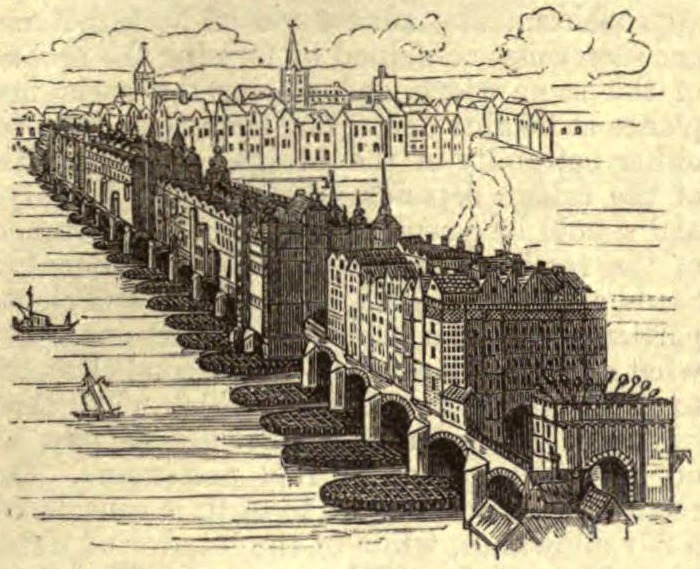
See page for author [Public domain], via Wikimedia Commons
Going back a hundred or so years, by Tudor times there were some two hundred buildings on the bridge and some were up to seven storeys high and still, buildings were added such as the palatial Nonesuch House in 1577.
There was immense congestion with traffic coming in both directions and to add to the fun, I am told that the less secure structures sometimes fell into the Thames (hence the song).
On a slightly more fun note, the bridge was also used to display the severed heads of traitors impaled on spikes (after being dipped in tar and boiled to preserve them against the London weather).
William Wallace was the first to appear followed in no particular order by Jack Cade, Thomas More, Thomas Cromwell and many others. A German visitor once remarked that he counted over thirty heads on the bridge. The practise was supposed to have ceased in 1660 when Good King Charles came to the throne but was reported as late as 1772. Today, if the practice was still in operation, I can think of a few candidates for the honour but will leave my humour there (all suggestions on a plain white envelope please).
During the rationalisation of the bridge (1758-1762) all the houses and shops were demolished (that is if they had not fallen in already) and to improve navigation, the central arches were modernised. But the bridge was past its working life and was dying on its feet.
In 1799 a competion was held to design a replacement for the old medieval bridge.
Thomas Telford threw his hat into the ring amongst others, but a design by John Rennie won the competition and in 1824 work commenced. As the new bridge was situated some one hundred feet away from the old one, the medieval bridge continued to be used until the new bridge was completed in 1831. The old bridge was then demolished without ceremony.
The new London Bridge cost an amazing £2.5 million pounds to complete which taken at today’s costs, would be some £208 million. This bridge was some 928 feet long and was constructed out of Haytor granite. It was opened by King William the Forth and Queen Adelaide on the 1st of August 1831 with great celebration. It proved very popular and by 1896 was the busiest point in London with some 8000 pedestrians and 900 vehicles using it every day. Due to this congestion, it was later widened by thirteen feet using granite corbels but there was a problem. The bridge was sinking.
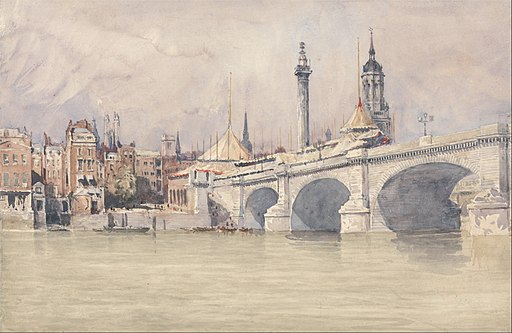
https://upload.wikimedia.org/wikipedia/commons/6/6a/David_Cox_-_The_Opening_of_the_New_London_Bridge_-_Google_Art_Project.jpg [Public domain], via Wikimedia Commons English artist. painted in 1831
By 1924 the east side had sunk by some four inches and this was not going to stop as it was sinking at a rate of about an inch every eight to ten years. It was decided that the bridge would have to be replaced and in 1967 the bridge was put on the market. A council member had suggested selling the bridge, although the idea initially seemed a little odd. But as with all crazy ideas there was an element of foundation and here is where the strange story begins.
On the 18th of April 1968 London Bridge was sold to an American entrepreneur Robert P McCulloch. His idea was that the bridge be taken apart with each part carefully numbered and shipped via the Panama Canal to California and then on to Lake Havasu City in Arizona. It was to span the Bridgewater Channel and act obviously as a bridge but also as a tourist attraction. It was a hare-brained idea but it worked against all odds and can be found in its new location to this day after being rededicated in October 1971.
I can hear a question from the audience. If the bridge was taken down stone by stone how is it possible that you have a piece of the granite from this bridge not far from where you are writing this article? This confused me at first, but I soon found the answer as some of the stones from the bridge did not make it to sunny Arizona and were left behind at the Merrivale Quarry in Princetown in Devon. This quarry was abandoned in 2003 due to flooding and the remaining stones were sold in an online auction. That is where my block of granite came from and although I have studied photographs of the 1831, bridge I have no clue to its location, although the weathering indicates that it was exposed, But then again, Princetown is not exactly Arizona so I can only guess as to its location on the Rennie bridge.
If I have whetted your appetite with regard to Rennie’s bridge there is no need to travel to Arizona to see an example of his work as between Bradford on Avon and Bath there is a magnificent aqueduct which I have visited on many occasions. If you travel along the railway between Bath and Bradford or in the opposite direction, then you will pass under it. Although it is crumbling a little it is a magnificent sight and can be crossed on foot or along the Kennet and Avon Canal.
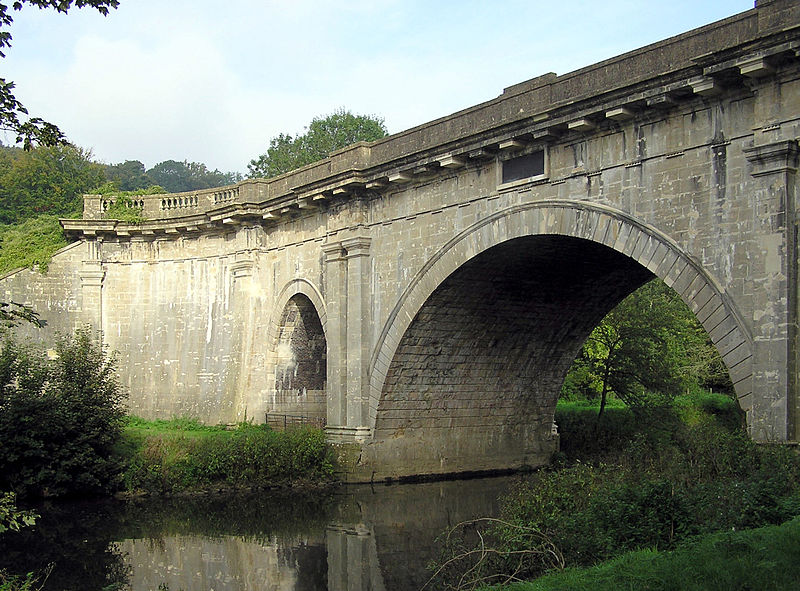
Dundas Aqueduct
The new bridge which was opened in 1973, is a familiar sight and most of us have crossed in on numerous occasions. The structure comprises of three spans of pre-stressed concrete box girders and is 928 feet long and it was built to last. It later survived a collision with HMS Jupiter in 1984 which caused damage to both ship and bridge.
The new London Bridge also featured in the 2002 movie, About a Boy starring Hugh Grant. Whilst the 1831 bridge was noted in The Wasteland by TS Eliot in which he compares the faceless London commuters to the hell-bound souls in Dante’s Divine Comedy. I am off to Margate next week to see an exhibition on Eliot’s famous work and wonder if London Bridge will be featured.
You can find most things at most times in the Arcade, but I was rather surprised when I found that small piece of granite late of London Bridge and I have retired it to one of my shelves as I think that after all these years it needs a rest.
Who knows, you might find another piece of the bridge when you visit the Arcade as London buses always come in pairs so why not London bridges.
Good luck in your future searches and perhaps, if you brave the Devon mists, you might find a few pieces of the bridge in the Princetown quarry.
Sadly, our most recent memory of London Bridge was the ghastly terrorist attack in June 2017 in which eight poor people were killed either on the bridge or in the nearby Borough Market area. I dedicate this short article to those who died or were injured on that dreadful day.
Stuart Miller-Osborne
Hungerford Arcade Congratulations to the Happy Couple
Hungerford Arcade Royal Wedding Fever
Hungerford Arcade: Family History On A Postcard
I published this article recently in our monthly newsletter but thought it was worth sharing again for those who may have missed it. It’s an example of the kind of history you can find in the simplest of things while browsing in a place like The Arcade. Thanks to Jane Elliman for taking the time to write this for us.
I spotted these two postcards in the Junk Shop the other day and was immediately drawn to the images so decided to see if there was any text on the back, so I was even more interested to discover they were both addressed to the same private house in Bristol. The post-mark isn’t readable and one stamp had already been removed but I guessed they must have been sent around the beginning of the 20th Century. The beautiful “Pre-Raphaelite” girl postcard is a birthday card to a Mrs Wright from her “loving daughter May” and the Little Miss Muffett card is to Miss May Wright with “lots of kisses from Dadsy and he hopes you are well and a good girl”.
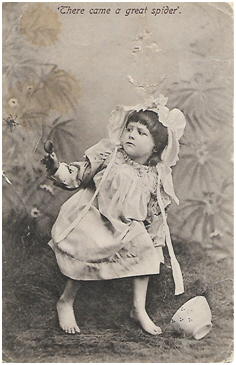 Well, this was all I needed to find out a little more about this family so at the earliest opportunity (as soon as I got home) I logged onto my Ancestry account and started with the 1911 census. It didn’t take me long to find a family that seemed to fit and a quick check of the front page of the census confirmed it was indeed the correct address that was on my postcards of 139 Cromwell Rd, Montpelier, Bristol.
Well, this was all I needed to find out a little more about this family so at the earliest opportunity (as soon as I got home) I logged onto my Ancestry account and started with the 1911 census. It didn’t take me long to find a family that seemed to fit and a quick check of the front page of the census confirmed it was indeed the correct address that was on my postcards of 139 Cromwell Rd, Montpelier, Bristol.
So we have Thomas George Wright aged 60 married who is employed as an Inspector of Schools whose birthplace is Stoke Priors, Worcestershire. His wife is listed as Maria Susan aged 44 having been married 12 years with one child………but……. the census continues with Gladys Martha listed as daughter aged 23 working as a Teacher in an Elementary school as well as Beatrice May aged 11, who must be the recipient and sender of the postcards. So, who then is Gladys and who was her mother as it couldn’t possibly be Maria Susan?
I moved further back in time to the 1881 census and searched for Thomas George Wright to see where he was and what he was doing then. I found him living in York, married to Mary Hannah with a daughter Kathleen aged 1 year. His occupation is listed as a Lecturer in a training college.

By 1891 they had moved from York to 139 Cromwell Road in Bristol with a further 3 siblings for Kathleen; George, Gladys and Horatio. It’s apparent now that something must have happened to Mary Hannah as by the 1901 census Maria Susan is listed as his wife with Beatrice as 1 year old. Kathleen, George Gladys and Horatio Herbert are all still present at the address.
A search of the death registers for Bristol between the years of 1891 & 1900 revealed that Mary Hannah died in 1897 aged 43. A further search of the marriage registers between 1897 and 1900 revealed that Thomas then married Maria Susan Biggs on the 4th August 1898.
I was then able to search and see that Thomas passed away aged 70 in 1921 and Maria aged 83 in 1949.
Sadly no-one seems to be researching these family names on the Ancestry website so one can only assume the family line has finished which is how the cards ended up in an Antique Centre.
This all goes to show that a simple item such as a postcard with an address on can easily reveal a family history and for some people can become a fascinating hobby or even occupation.
There are many websites and magazines that cover the subject as well as groups and society’s and even fairs up and down the country. Most websites are subject to a membership fee and basically the more you pay for your subscription the more you can research. To follow your research back beyond civil registration in 1837 you will undoubtedly have to visit some record offices. Each county town will have their own archives and many hours can be involved in scrolling through microfiche copies of early records.
I am a member of the Hampshire Genealogical Society and subscribe to Ancestry, Genes Reunited and 192.com.
Jane Elliman
April 2018
Hungerford Arcade “World Village Market”
Hungerford Arcade has been buzzing again this weekend and the High Street was alive with fun and laughter as the World Village Market came to town. There was mini fairground rides, cheeses, freshly cooked paella, in fact, everything you can think of.
Frys Teak, owned by Billy Fry had the most amazing things. Life-sized horses and donkeys. garden furniture made from 3,000 year old teak and comical pigs with moving arms and legs.
Hungerford Arcade thank all the organisers for such a fantastic market.

The Antiques Fair & Flea Market was also on at the Town. This beautiful Cadillac dress on the vintage clothes stall was just one of the many was one of the many





